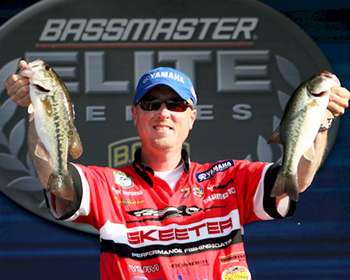
Listening to Elite Series pro Mark Burgess describe his favorite shades of his go-to soft plastic color, green pumpkin, is like listening to him read off a restaurant menu.
There are green pumpkin laminates, flakes that run the gamut from gold to purple to black to red and all sorts of variations of shading. Just about every manufacturer worth its space on a tackle store shelf has a version or three of green pumpkin, they just can't seem to agree on exactly what it should look like. "There are all sorts of different shades of it," Burgess says. "Some of them are actually two-toned, with green on one side of the bait and brown on the other.
The most common one is more of a brownish version of green pumpkin." That's the one Burgess relies on in most cases. But if you think he just throws a single bag of baits into his boat and fishes them straight out of the package, you'd be taking oversimplification to new extremes. In this age of increased pressure and increasingly wary fish, every angler needs an edge.
For Burgess, the first option is to use a marking pen on the claws or tail. "More times than not, I use an orange Spike-It pen," he says. "I have confidence in that. A lot of fish have orange on their bellies. Golden shiners have bright orange fins, and of course yellow perch have a lot of orange on their undersides.
Crawfish do, too." Why not rely on chartreuse more often, like many of his peers do? "Most guys use chartreuse; it's a standard thing," he replies. "It still works and, just like a standard white-and-chartreuse spinnerbait, a lot of money has been won on it. But I like to do something a little different." Even more "different" are those occasions when he puts down the orange marker in favor of a blue one. He particularly likes this when he's focused on a concentrated group of fish and is making repeated passes through the area. "When I'm fishing a marina and have been through it several times, the next time around I'll mark my green pumpkin plastic with a blue marker," he says.
"Especially if I see bluegill around." When flipping, green pumpkin is his baseline color. In water ranging from clear to stained, it's where he'll start. He tries different colors of flakes in the color, and different bait sizes to adapt to the bite and the prevailing forage.
On his second or third pass through an area, he'll begin the alteration process. Sometimes it's just a matter of going to a different size or shape plastic; other times, he'll try a different colored flake. While he'll often use a black or red tungsten sinker to accent his flipping baits, when he wants to downsize his lure without changing the lure itself, he'll add a green pumpkin sinker that matches his lure precisely, creating the illusion of a more compact package.
While Burgess most frequently runs through the whole palette of green pumpkins when flipping, he's also experimented with them in the drop shot context. His sponsor, Reaction Strike Lures, has asked him to experiment with dozens of shades, and the one that works most often is "a green pumpkin with a purple hue toward the back of it." Why hasn't he mentioned the color "watermelon"?
Burgess is aware that this family of colors, like chartreuse dye, catches tons of bass, and he uses it as well. But when times get tough, he'll always return to green pumpkin.
(Provided by Z3 Media)





